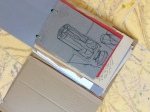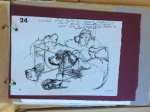Local Course – Exploring Drawing and Mark Making
January 2018
Since being resident in Lanzarote I have attended many classes run by a local tutor, and now friend, including life drawing, general painting and abstraction. In January we started a four-week run of classes looking at drawing and mark making. She very kindly, offered to look at what I was doing with the Drawing 2 course and work along a similar vein, encouraging us to get out and about and to be more experimental.

Having the luxury of a class of only two, we had a lot of attention and guidance. Our first class was an exercise in observation plus a little challenge. Choosing a simple object or two as a still life each, were asked to make a drawing. My fellow student was very accomplished at delicate line drawings and was tasked with a tonal charcoal rendition of her object, whereas, I tend to the more tonal and less delicate, shall we say. I had two small interestingly shaped glass bottles to draw in line only. This was very enjoyable as I took it that I could draw all the tonal edges as well as the actual outlines. The result was quite pleasing, once I got into it. Using differing line thickness and weight added a dimension of perspective and form in another way.

Initially, we looked at composition and how to decide what was important and to what we wanted to draw attention in an image. We used a few black and white photos and a red marker to draw around where our eyes followed. We further explored this by going outside armed with red twine/string and finding an area we thought interesting. Using the string we secured one end and decided between us where we wanted the viewer’s eye to follow, draping the string and circling what we wanted them to notice in the scene. This worked well with fairly green vegetation and the red of the twine although a little difficult to see in the photo. This may be an element to revisit in Project 6 – Personal Project of the Drawing 2 course. Whilst we were doing this, we had employed the natural surroundings to create a drawing or two of its own!

Before embarking on the string draping, we had set up a couple of work stations so to speak. Lanzarote is often a windy island, with some strange and wonderful flora, spiky cacti, rustling palm trees of surprising variety and spindly, “growing where they can” wild plants. We laid out lengths of paper on the ground beneath various plants/trees, suspended charcoal and felt tip pens with string or wire from the plants, and then let the trees draw with the help of the wind.

We had to play with how the charcoal and pens would be suspended. The wire seemed to be the most successful tool by being less flexible and keeping the drawing implement actually on the paper. The charcoal required more weight so we had to attach a stone with tape and string to keep it on the paper. However, when we looked at the finished drawings, the charcoal suspended on the string had much more delicacy due to it being more at the mercy of the wind.

There was some video taken which really demonstrated how the wind was moving everything around, not only the charcoal and pen but also lifting the paper which assisted the mark making. Unfortunately, I need to understand how to embed this into my blog. Hopefully, to be updated!

The resulting charcoal drawing was so delicate yet busy, the overlapping marks increase the tone in places and almost give a form and shape that tapers off. I think that this may be my favourite and begs the question if it was left longer, how much more substantial and solid would the form have been.

There were two pen drawings in the end, this one shows how the pen remained in more or less one spot for some time. This absorbed a lot of ink and made for a solid shape with some more expressive marks coming from it. It almost has an insect-like quality about it.

This final pen drawing appears to have gone on more of a journey. If I remember rightly, the pen refused to move a lot at first so the paper was re-positioned. Once this was done, the wind caught hold of the paper and pen and a more expansive area was drawn.
This experiment is also something to explore further with my personal project – that is, not only for me to draw the landscape but for the landscape itself to contribute.

Another task we were given was to collect odd scraps of paper up to around A5-A4 size. This meant anything, newspaper, old greetings cards, instruction leaflets, writing paper etc. I collected grease-proof, old IKEA instructions, brown wrapping, graph, pastel papers etc. We brought our findings along to the next class and we then made a very rustic and simple sketch book each with cardboard from old boxes as covers. Holes were punched in the paper and the back cover and string was threaded through to bind them all together. When I got home, I fashioned a clasp from string and a brass paper pin and stuck bits and pieces of art related collage on the cover. Things such as tickets for museums, rippings from exhibition brochures and some general Lanzarote magazine scenes. Very basic but effective.
We therefore had a selection of papers to draw on, not only as a point of interest, but also to negate the feeling of being precious about our drawings. We were to make a drawing each day, it didn’t have to be a masterpiece, it may only take seconds, but it was to instil the habit of drawing everyday. Here’s selection:

On another beautifully sunny day, we gathered in Betty’s garden and had some fun with paint, pastels, inks and masking fluid. The first time any of us had had a go at using the blow spray gadget – nigh on impossible at first, but we finally had a bit of success. We also experimented with masking fluid to build layers, straws to blow ink around and generally dribbling and splattering ink. Great fun but not sure about the result!

Our final lesson was very interesting. As we had decamped to my home, we went outside and tried shutting our eyes and drawing the sound of the sea crashing against the rocks. A very surreal thing to do but very liberating – unfortunately, I can not find the drawing now! Then we began another little painting by looking outside and drawing the negative shapes around buildings, plants and any other man-made or natural structures we could see. Bringing these line drawings back to the table we applied random masking fluid, dribbles of paint and newly acquired acrylic spray inks (so much easier than the contraption we’d tried to use previously). The abstract has benefited from a less frantic choice of multiple colours and some considered line drawing as well as the random application of masking fluid and sprayed acrylic ink. Although I still think the best bit was taking off the masking fluid!

While these were drying, we were given another exercise. We each had to look around the house for a small object without the other seeing what it was, and then had to describe it to the other so that they could draw what was described. The describer could not see the drawing. This was fascinating, frustrating and hilarious in equal measures. Strangely, looking at this now, I really like the odd composition – when we did this I had not yet explored Matisse. I can now see that with some colour this could be very Matisse-like. The object by the way, was a small Spanish ceramic bowl, decorated with linear pattern, dots and simple flower shapes. All sides had been described to me, inside, underneath and all round.
Our classes are over for a while now, however, I must grab the opportunity again when the time is right.




